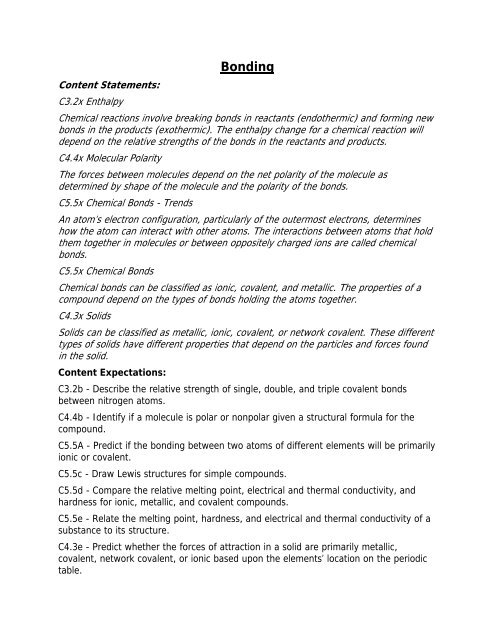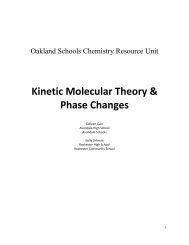Create successful ePaper yourself
Turn your PDF publications into a flip-book with our unique Google optimized e-Paper software.
Content Statements:<br />
C3.2x Enthalpy<br />
<strong>Bonding</strong><br />
Chemical reactions involve breaking bonds in reactants (endothermic) and forming new<br />
bonds in the products (exothermic). The enthalpy change for a chemical reaction will<br />
depend on the relative strengths of the bonds in the reactants and products.<br />
C4.4x Molecular Polarity<br />
The forces between molecules depend on the net polarity of the molecule as<br />
determined by shape of the molecule and the polarity of the bonds.<br />
C5.5x Chemical Bonds - Trends<br />
An atom’s electron configuration, particularly of the outermost electrons, determines<br />
how the atom can interact with other atoms. The interactions between atoms that hold<br />
them together in molecules or between oppositely charged ions are called chemical<br />
bonds.<br />
C5.5x Chemical Bonds<br />
Chemical bonds can be classified as ionic, covalent, and metallic. The properties of a<br />
compound depend on the types of bonds holding the atoms together.<br />
C4.3x Solids<br />
Solids can be classified as metallic, ionic, covalent, or network covalent. These different<br />
types of solids have different properties that depend on the particles and forces found<br />
in the solid.<br />
Content Expectations:<br />
C3.2b - Describe the relative strength of single, double, and triple covalent bonds<br />
between nitrogen atoms.<br />
C4.4b - Identify if a molecule is polar or nonpolar given a structural formula for the<br />
compound.<br />
C5.5A - Predict if the bonding between two atoms of different elements will be primarily<br />
ionic or covalent.<br />
C5.5c - Draw Lewis structures for simple compounds.<br />
C5.5d - Compare the relative melting point, electrical and thermal conductivity, and<br />
hardness for ionic, metallic, and covalent compounds.<br />
C5.5e - Relate the melting point, hardness, and electrical and thermal conductivity of a<br />
substance to its structure.<br />
C4.3e - Predict whether the forces of attraction in a solid are primarily metallic,<br />
covalent, network covalent, or ionic based upon the elements’ location on the periodic<br />
table.
















